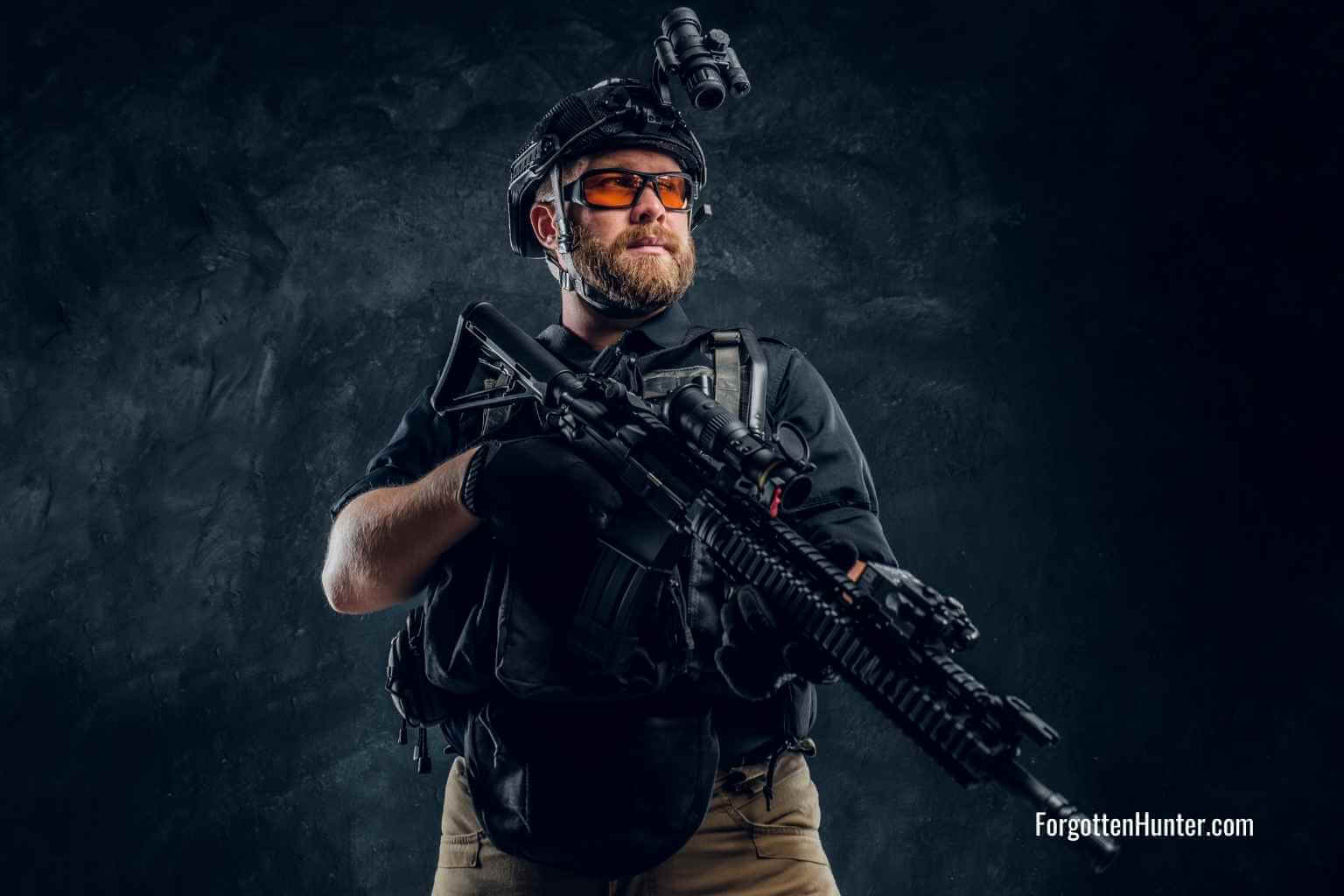Would you like to spot animals on a night hike or feel safer while camping? Then buy a night vision monocular so you can have an idea of what’s going on around you at night. We have reviewed and compared several night vision monoculars!
Hunting at night is very different from hunting during the day. At night, you not only have to adopt different tactics but also use gear that specifically helps your nighttime hunting. Secondly, the animals you are going to hunt at night are very different from those during the day. During the day, you have deer, turkey, and rabbits to hunt, while at night you are looking for other animals like wild boars, coyotes, and foxes.
It can be pretty difficult to choose a good night vision monocular. There are so many different models, features, and brands to consider. There are also so many other factors to consider, ranging from the build quality to the price tag. With this in mind, it can be hard to decide which device is the best value for your money.
To help you narrow down your choices, we’ve decided to do a thorough review and rating of the best night vision monoculars.
Table of Contents
The 10 Best Night Vision Monoculars for 2025
When looking for good night vision monoculars then you should consider the generation, field of view, viewing distance, brightness, ease of use, and the cost. Commercial night vision monoculars may not be as powerful as Military-grade night vision monoculars, but they can be a very handy accessory for anyone that hunts at night.
If this is your first time buying a night vision monocular, we highly recommend reading our buyer’s guide first. We’ve included all the information you need to know about night vision monoculars.
AGM Global Vision PVS-14-51
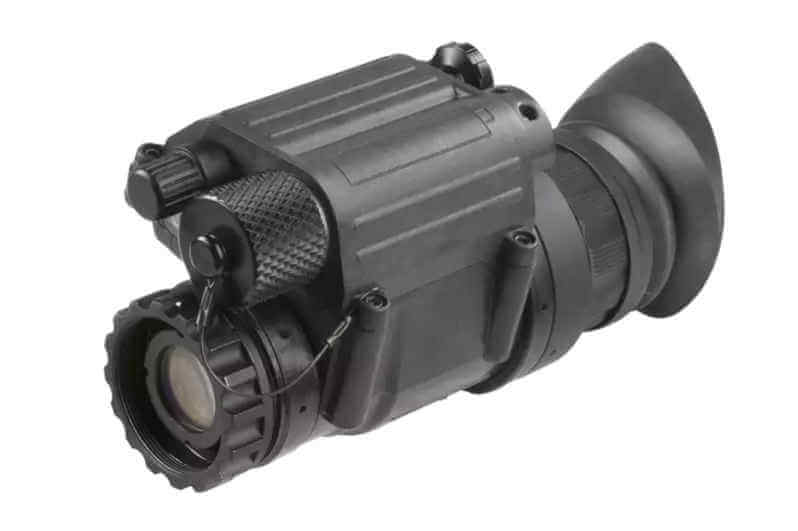
- Generation: 3+
- Objective Lens Diameter: 19 mm
- Angular field of view: 51°
- Magnification: 1x (3x and 5x optional)
- Battery type & amount: 1x AA
- Battery life: 50 hours
- Image Intensifier Color: White Phosphor Level 2
- Weight: 12.4 oz
The AGM Global Vision PVS-14-51 with the 3AW2 tube is the best commercially available night vision monocular. This generation 3+ night vision monocular has been graded at MIL-STD-810G United States Military Standards, which means that it’s water, shock, vibration, and weatherproof and should last a very long time.
While pretty much all generation 3 night vision monoculars have a 40 degrees field of view, the PVS-14-51 with 3AW2 tube has a 51 degrees field of view! This means that you’ll be able to see much more.
Unlike the AGM Global Vision Wolf-14, the PVS-14-51 is compatible with PVS-14 gear. You can easily mount the PVS-14 on your helmet or rifle for hands-free use.
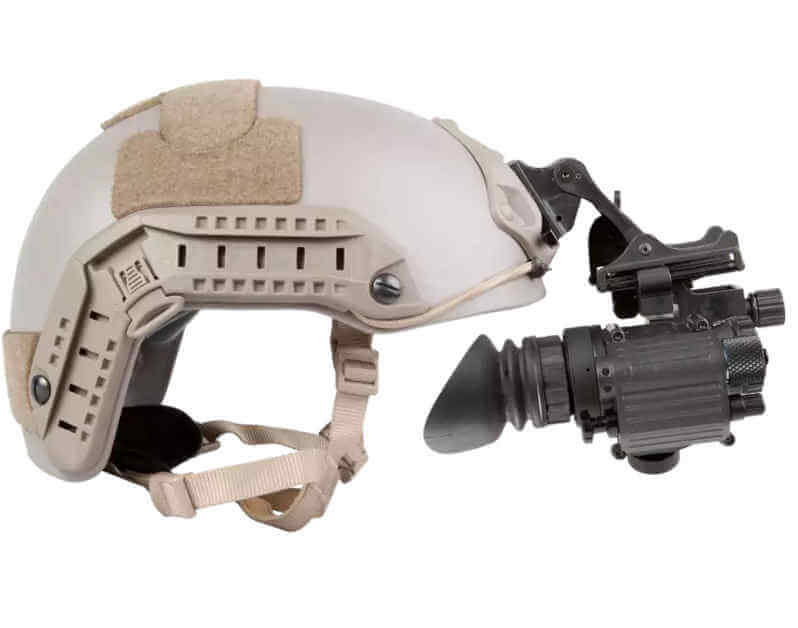
The AGM Global Vision PVS-14-51 is equipped with a generation 3 auto-gating tube and an automatic shut-off feature that protects the photocathode against being exposed to too much light. A feature you’d expect from a night vision monocular in this price range, but worth mentioning nonetheless.
During optimal conditions, the AGM Global Vision PVS-14-51 should last 50 hours on a single battery charge. This of course also heavily depends on the use of the built-in IR-illuminator.
Overall, the AGM Global Vision PVS-14-51 with 3AW2 tube offers the best image quality available, has intuitive controls, is easy to use, and is very durable.
What we like
- Generation 3+
- Durable
- 50 Degrees angular field of view!
- Best image quality available
- Low artifacts
- White Phosphor Color
- Also available in different tubes
- Can be mounted to all PVS-14 gear
- Lightweight
- Water, weather, shockproof
- Easy to use
What we don’t like
- Expensive
- Expensive accessories like mounts
ATN PVS14 Gen3
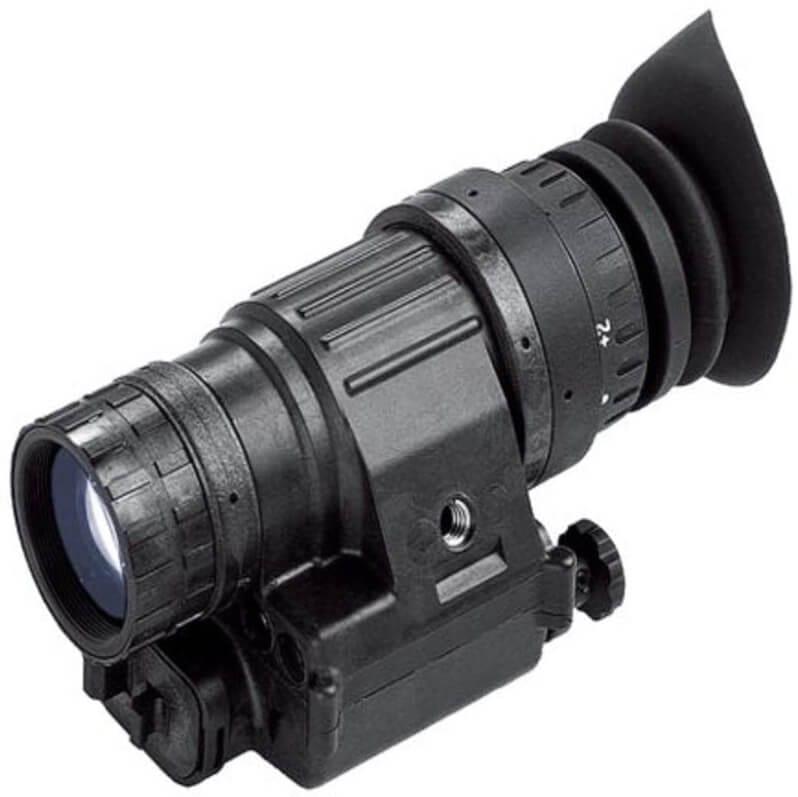
- Generation: 3
- Objective Lens Diameter: 27 mm
- Angular field of view: 40°
- Magnification: 1x
- Battery type & amount: 1x AA
- Battery life: 40 hours
- Image Intensifier Color: Green Phosphor
- Weight: 12.5 oz
Second on our list is the ATN PVS14-3 with a green phosphor generation 3 tube. It’s a lightweight night vision monocular that provides crystal clear images.
While the ATN PVS14-3 is comparable to the AMG PVS-14-51, we prefer the white phosphor color over the green phosphor color. Getting a green phosphor tube does save quite a bit of money though!
The lens has a magnification of 1x, which means that you get the same field of view as with your naked eye. It also has an IR illuminator which can be activated manually or automatically to make sure that you can see what’s happening in low light conditions.
The ATN PVS14-3 can also be easily mounted to a helmet or rifle or mounted to cameras or camcorders.
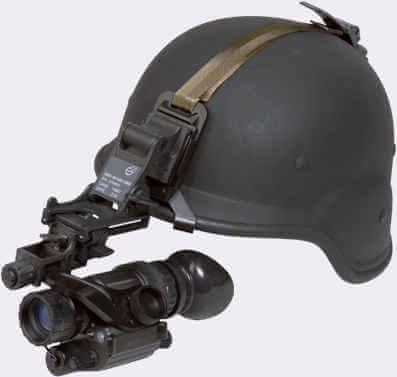
Overall, the ATN PVS14-3 night vision monocular is a huge improvement from a generation 2 device and a great tool for hunters, campers, or other outdoor enthusiasts!
What we like
- Great and bright image quality
- Very few specks/dots
- Lightweight
- Durable
- Also comes in a more expensive white phosphorus image
- Easy to use
What we don’t like
- Expensive
- The Head strap is worthless
ATN NVM-14-2
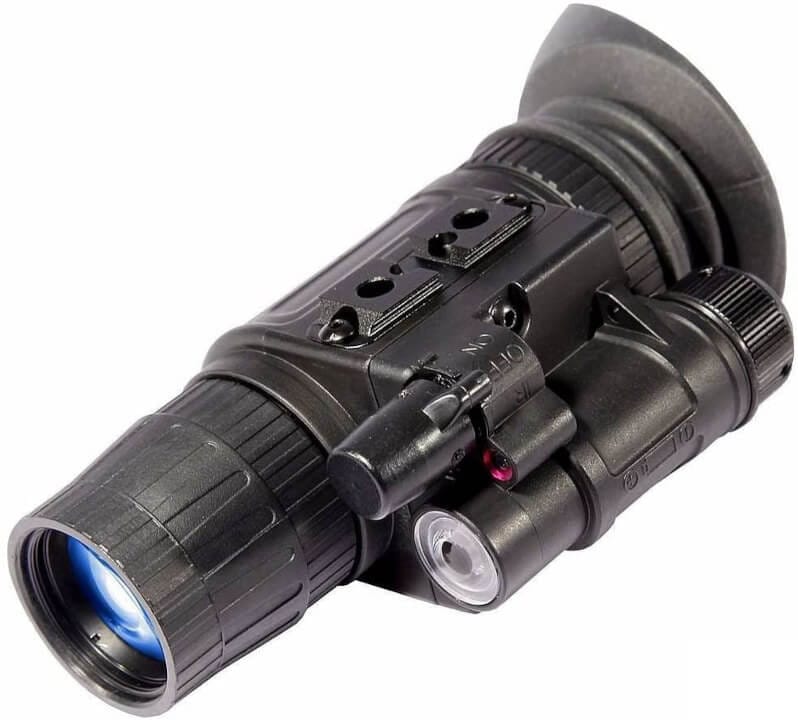
- Generation: 2+
- Objective Lens Diameter: 27 mm
- Angular field of view: 40°
- Magnification: 1x
- Battery type & amount: 1 x CR123A
- Battery life: 60 hours
- Image Intensifier Color: Green Phosphor
- Weight: 10 oz
ATN NVM-14-2 is a high-quality generation 2+ night vision monocular that is perfect for outdoor activities. It has a wide field of view and it can be used in complete darkness with the help of infrared technology. You’re easily able to view up to 200 yards with this device.
The NVM-14-2 produces a very bright and clear image for a generation 2 night vision monocular. You can see the difference between the NVM-14-2 and a generation 3 monocular, but if you’re not a professional or have the budget, the price difference is hard to justify.
With an extra mount from ATN, you can easily install the ATN NVM-14-2 to a helmet or rifle. This night vision monocular is also durable, waterproof, and fog proof. It’s an excellent choice for hunters and campers who don’t need the highest quality device available or have an unlimited budget.
What we like
- Durable
- Amazing quality for gen2
- Compact
- Lightweight
- Long battery life
- Much more affordable than a gen3
What we don’t like
- Non-standard mounting
- ATN rail is flimsy
- Not as good as a gen3
AGM Global Vision Wolf-14 Multi-Purpose
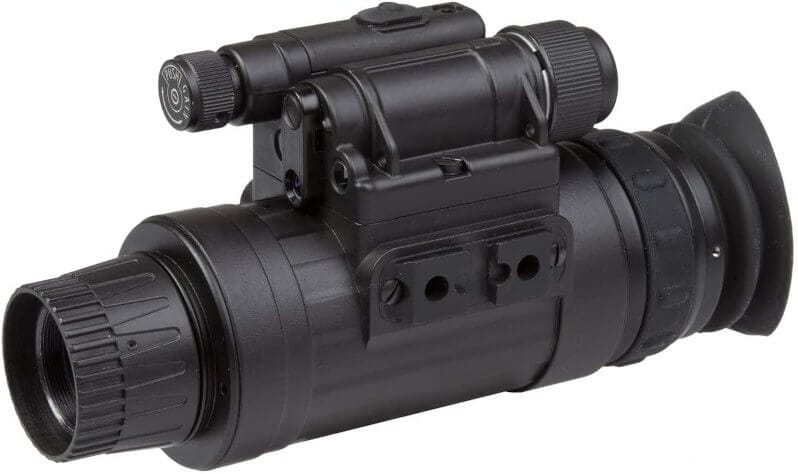
- Generation: 2
- Objective Lens Diameter: 27 mm
- Angular field of view: 40°
- Magnification: 1x (3x and 5x optional) fixed
- Battery type & amount: 1x CR123A lithium battery or AA Alkaline
- Battery life: 40 hours
- Image Intensifier Color: White Phosphor
- Weight: 16 oz
The AGM Global Vision Wolf-14 Multi-Purpose is a generation 2 night vision monocular with high-tech features. The Wolf-14 is available with image intensifier tubes in green or white phosphor.
The white phosphor tube offers more details and a much clearer picture than the green phosphor tubes.
The Wolf-14 is able to show clear images up to 200 yards in low light conditions. In extremely dark conditions, you’ll definitely want to make use of an IR-illuminator to see clearly.
While the Wolf-14 is pretty cheap compared to other generation 2 night vision devices, a huge downside to this monocular is the fact that it uses a custom mounting system. This means that this device won’t fit PVS-14 gear without extra plates that are only available from AGM.
What we like
- Very bright and clear White Phosphor image
- Great monocular for the price
- Lightweight
- Compact
- Durable
What we don’t like
- Non-standard mounting
Bering Optics Wake2
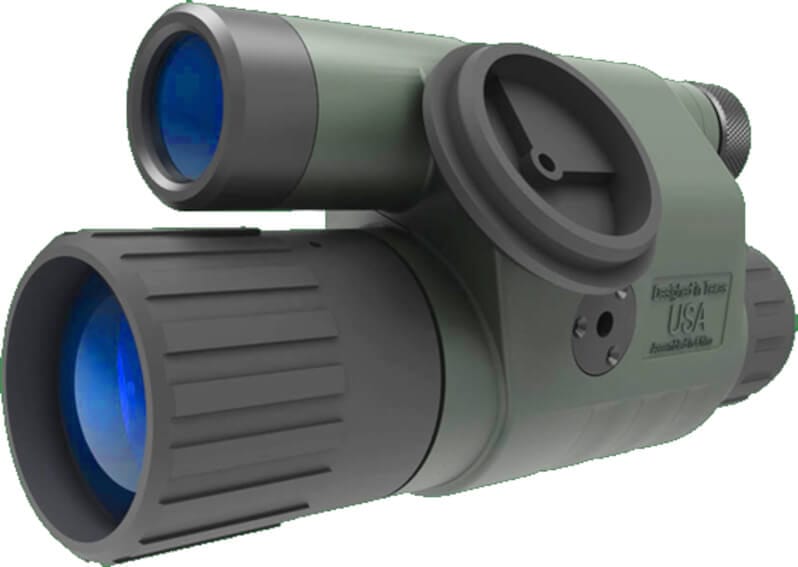
- Generation: 1
- Objective Lens Diameter: 40
- Angular field of view: 14°
- Magnification: 2.5x fixed
- Battery type & amount: 1x CR123
- Battery life: 60 hours
- Image Intensifier Color: Green Phosphor
- Weight: 12 oz
The Bering Optics Wake2 is a high-quality first-generation night vision monocular. This lightweight and inexpensive monocular allows you to view objects and animals up to 50-yard distances in low light conditions. With a full moon and plenty of residual light, the Wake2 is able to provide clear images up to 200 yards!
While most generation 1 night vision monoculars have a maximum battery life of 45 hours, the Bering Optics Wake2 can run for up to 60 hours on a single battery charge.
Another unique feature not found on other generation 1 night vision monoculars is the automatic shut-off after being exposed to too much light for 2 seconds. This protects the image intensifier tube from becoming damaged.
The Bering Optics Wake2 features a water-sealed housing, rated at IPX4, which means that you can use it in the rain, but it won’t survive getting submerged.
What we like
- Amazing quality gen1
- Long battery life
- Auto shut-off
- Built-in tripod socket
- Inexpensive
- Great entry-level night vision monocular
What we don’t like
- No wrist or neck strap
- Could use a more powerful IR illuminator
Luna Optics G3
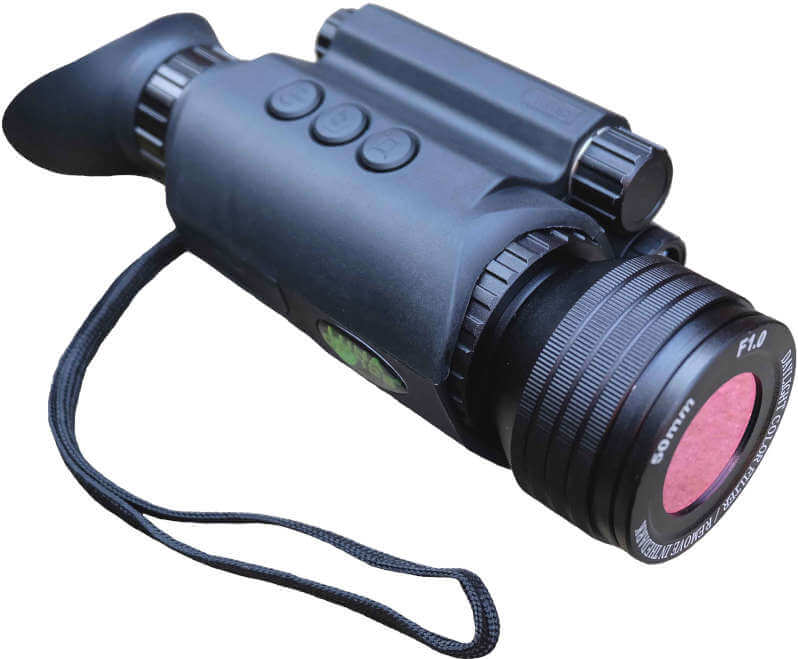
- Generation: Digital
- Objective Lens Diameter: 50 mm
- Angular field of view: 9°
- Magnification: 6 – 36x
- Battery type & amount: 2x CR123 lithium battery or Power banks
- Battery life: 3.5 hours
- Image Intensifier Color: Green Phosphor
- Weight: 17.6 oz
The Luna Optics G3 is a digital night vision monocular with excellent image quality. This device can also be used during the day by switching the daytime color filter on.
The Luna Optics G3 has a 50 mm objective lens and a 12.2 MP still image camera and by using an AMOLED-Q display with Quad-Pixel technology, you’re able to view images in HD quality and record video in Blu-Ray quality.
One of the big selling points of the Luna G3 is the built-in Infrared illuminator. This powerful digital night vision monocular is able to provide clear images up to 438 yards!
During our testing, we were very happy with the Luna Optics G3. Overall, it’s an amazing night vision monocular that’s comparable to higher quality generation 2 devices but the Luna G3 has a more affordable price.
One major downside is the battery life. With CR123 lithium batteries, we were not able to get anywhere near the advertised 3.5hours battery life. Highly recommended to use a powerbank.
What we like
- HD AMOLED-Q
- Comparable to gen2
- Different color modes
What we don’t like
- Battery life is nowhere near advertised
SiOnyx Aurora Pro Explorer
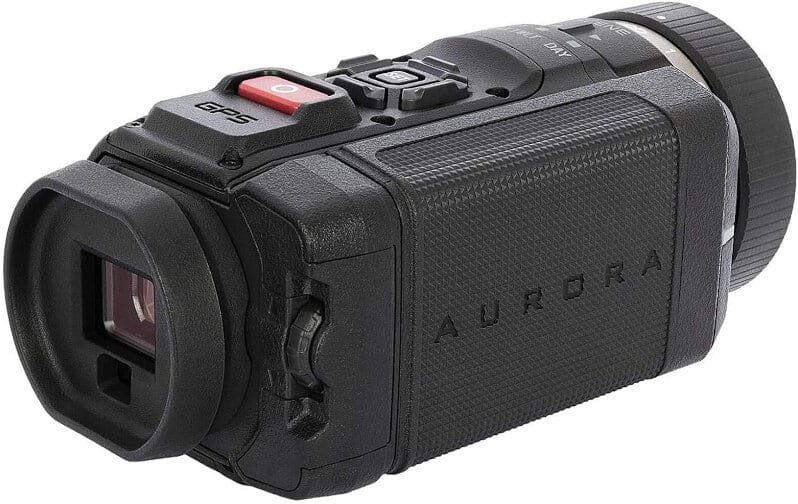
- Generation: Digital
- Objective Lens Diameter: 16 mm
- Angular field of view: 44°
- Magnification: 3x, 1 – 3x
- Battery type & amount: 2x Rechargeable Lithium batteries
- Battery life: 2 hours
- Image Intensifier Color: Full color, Green Phosphor
- Weight: 9.8 oz
The SiOnyx Aurora Pro Explorer is a WiFi-enabled full-color digital night vision monocular. Stream, capture, and view images on your smartphone or tablet in 720p quality.
The SiOnyx Aurora Pro works best if you use an IR-illuminator, so we recommend the Explorer package which includes an “IR flashlight”. Without the IR-illuminator, it doesn’t work that great for near moonless conditions. If you already own an IR illuminator, you’ll be fine by just getting the basic package and spending the savings on other accessories.
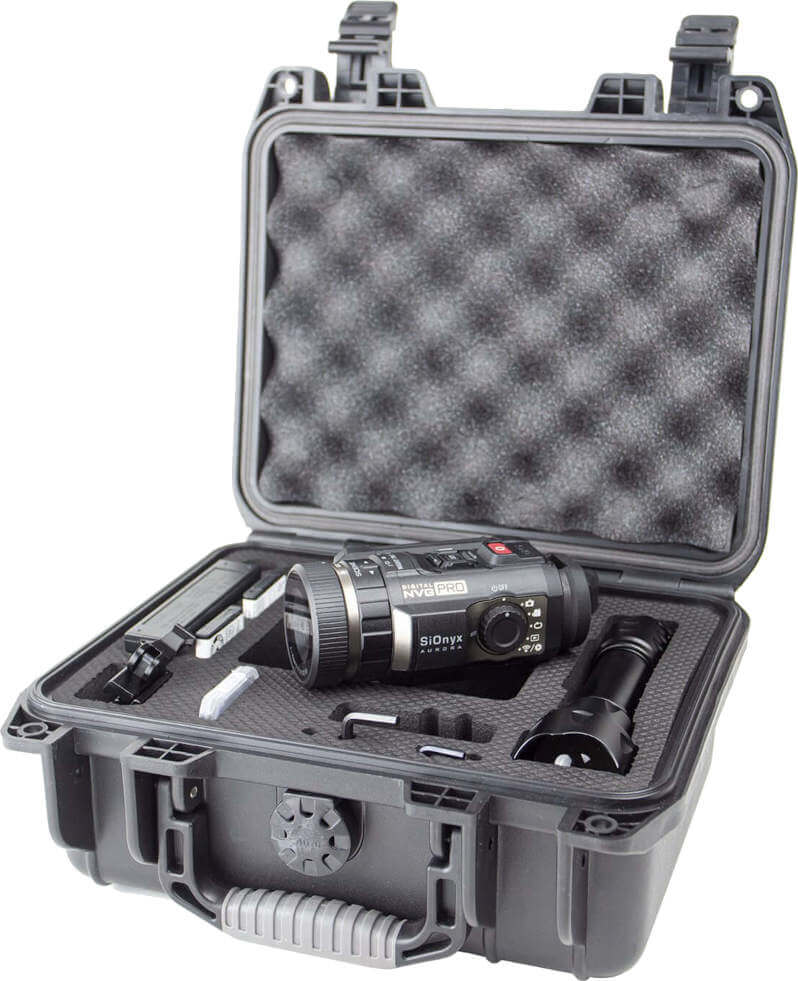
With an IP-67 rating, the SiOnyx Aurora Pro Explorer is submersible to 3 feet for 30 minutes. This makes it an excellent night vision monocular for wet weather conditions.
What we like
- Great quality for the price
- Affordable
- Explorer kit includes everything you need
- Ability to stream to iOs or Android device
What we don’t like
- Standalone monocular is not enough, need full kit to fully utilize the Aurora Pro
- Wifi connection /streaming to tablet or phone is not great
Night Owl Optics iGen NOIGM3X-IC
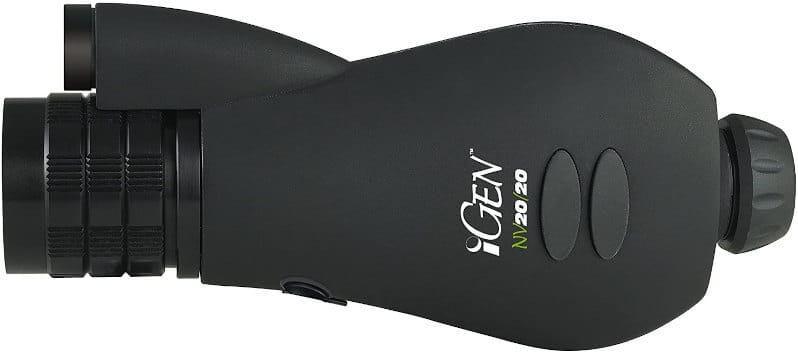
- Generation: Digital
- Objective Lens Diameter: 41 mm
- Angular field of view: 12°
- Magnification: 2.6 x
- Battery type & amount: 4x AA batteries
- Battery life: 2.3 – 4.5 hours
- Image Intensifier Color: Black & White, red, green, blue
- Weight: 21 oz
The Night Owl Optics iGen NOIGM3X-IC is a digital night vision monocular with image capture capabilities.
While you’re able to view live images in black and white, red, green, or blue, you’re only able to capture them in black and white. During our testing, we found that the black and white setting produced the highest quality images, so this shouldn’t be a problem at all.
With moonlight, the Night Owl Optics iGen NOIGM3X-IC is able to produce clear images up to 200 yards. Without the moon out, you’re still able to clearly see up to 100 yards.
Overall, the Night Owl Optics iGen NOIGM3X-IC is a great value. This monocular is comparable to higher quality generation 2 monoculars.
What we like
- High-quality image
- Comparable to gen 2 with affordable price
- Able to capture photos
- Ability to record with not included RCA cable
- 100 yards in low light, 200 yards with moon out
- Works day or night
What we don’t like
- Not able to mount
- No wrist or neck strap
Night Owl NexGen 4x NONM4X-I
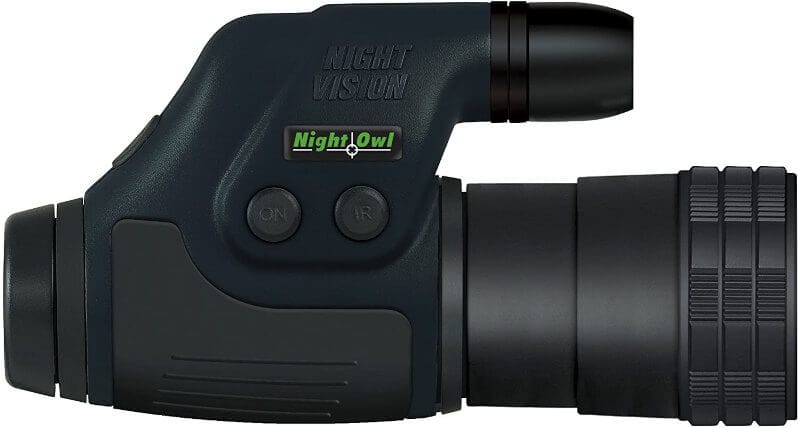
- Generation: 1
- Objective Lens Diameter: 50 mm
- Angular field of view: 14 degrees
- Magnification: 4 x fixed
- Battery type & amount: 1x CR123 lithium battery
- Battery life: 45 – 100 hours
- Image Intensifier Color: Green Phosphor
- Weight: 14.5 oz
The Night Owl NexGen 4x is probably the best generation 1 night vision monocular we’ve reviewed. This device features a high-quality 50mm lens that’s able to provide crystal-clear images up to 50 yards in complete darkness.
Scott actually used this device for several years before upgrading to a generation 2 monocular. He still recommends anyone that’s starting with night vision devices to try the Night Owl NexGen 4x first. During clear nights, he was able to spot animals at 100 yards easily.
The Night Owl NexGen 4x is weather-resistant and has a comfortable hold because of its rubberized body. While this makes it feel durable, dropping this device will almost certainly break it.
The Night Owl NexGen 4x powers on just one CR123 lithium battery. It’s advised to bring a couple of spare batteries with you if you plan on using the IR illuminator. The built-in IR illuminator drains the battery pretty fast.
What we like
- Great quality for gen1
- Decent range
- Long battery life
- Lightweight
- Cheap
What we don’t like
- Not that bright
- Narrow field of view
- Fixed magnification
Carson NV-200 Mini Aura Digital
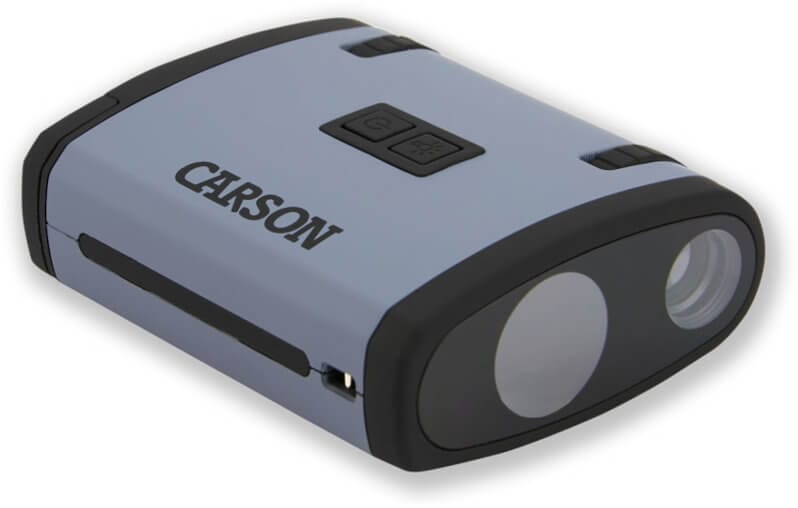
- Generation: Digital
- Objective Lens Diameter: 10 mm
- Angular field of view: 19 degrees
- Magnification: 1 x fixed
- Battery type & amount: 3x AAA
- Battery life: 1 hour
- Image Intensifier Color: Black & White
- Weight: 3.4 oz
If you’re just thinking of playing around with a night vision monocular without shelling out the big bucks, then the Carson NV-200 Mini Auro Digital is the best choice. It’s a very cheap and lightweight night vision monocular with an adjustable infrared illuminator.
While you shouldn’t expect much from the Carson NV-200, this tiny but powerful night vision monocular is able to produce clear images up to 82 feet. While testing this device with a pretty clear night sky, we were able to see deer at the end of the property, about 180 feet away, that we couldn’t see with our naked eye.
The Carson NV-200 also features an adjustable eyepiece focusing dial and objective lens focusing dial.
Note: The Carson NV-200 is available in 2 different versions. The Carson OPMOD NV-200 is an OpticsPlanet exclusive release that includes a carry pouch and wristband.
What we like
- Cheap
- Compact, pocket-size
- Uses AAA batteries
- Great to observe your property
What we don’t like
- Visible IR
- Short battery life
- Poor image quality
How to Choose the Best Night Vision Monocular
When it comes to night vision monoculars, it is important to understand what they are and how they are used.
The biggest issue with hunting at night is vision. Due to a lack of sufficient light, regular monocular or binoculars is not going to provide you with the necessary vision. Under such circumstances, a night vision monocular is going to be extremely helpful. Having a high-quality night vision monocular in your hunting gear will help you in many ways.
One benefit of night vision monoculars is their compact size. It is easy to take this product with you in your pocket when you are on the move. A monocular is also lightweight. The downside is that you can only see with one eye which is also a disadvantage to your depth perception. Most night vision monoculars have a maximum range of 1000 feet.
Generations
One of the more important things to know when it comes to night vision monoculars are the generations. The generation of a night vision monocular determines the quality of the product. There are three generations of night vision monoculars available. Each generation has a significant improvement over the previous generation. Generation 1 has the lowest quality but is very affordable and generation 3 has the best quality available for consumers but comes with a hefty price tag.
Generation 1
First-generation night vision monoculars are very easy to use. If you want to observe large objects like buildings or boats, or even secure your home, this type of night vision device is perfect. They amplify residual light about 500 times. The observed image may have distortion at the edges.
Generation 2
Second-generation night vision monoculars are more advanced and provide light amplification up to 2000x. Initially, this type was also made only for military or professional purposes. They are equipped with a micro-channel plate that acts as an additional amplifier. The cream of the crop are the generation 2+ monoculars, with exceptionally crisp image quality.
Generation 3
Third-generation night vision monoculars are currently used by the US Military. Contrary to popular belief, generation 3 night vision monoculars are available (and legal) for the US. Although there are even better night vision devices than these, generation 3 will be the highest quality for most consumers. These scopes are very pricey but provide the highest quality, amplifying light up to 50,000 times and allowing you to see clearly at hundreds of yards away.
Generation 4
Fourth-generation night vision monoculars are currently not yet available. You may see some devices being marketed as generation 4 but they’re actually “filmless” generation 3 tubes. These devices are currently used by the US Military and law enforcement.
When the US Military first tested these devices, they reported that the devices didn’t offer that much of an improvement to be classified as a new generation of night vision devices. They’ve officially classified these devices as generation 3 auto gated tubes.
Technologies
Residual light amplifier
One of the technologies a night vision monocular might use is a “residual light amplifier”, also called an image intensifier. The residual light amplifier picks up small particles of light and with the use of image intensification
The residual light amplifier consists of an electron tube that amplifies the intensity of the light still available in the dark. Finally, all those electrons strike a phosphor screen, which has the effect of producing light particles again in the right places so that a green (phosphor) image is created.
The range of a residual light amplifier is usually around 175-250 feet. More expensive night vision monoculars with residual light amplifiers can see more than 1000 feet away at night.
Infrared
In some cases, there is no residual light present, such as in complete darkness. Therefore, most night vision monoculars have built-in infrared illumination, and/or there is a possibility of installing an additional infrared illuminator.
A night vision monocular transmits infrared waves, which are reflected and recaptured by the monocular. This is then converted into a clear image.
Infrared night vision monoculars don’t need any other light source as the infrared itself acts as a light source. This allows you to see in total darkness
A night vision monocular that uses infrared is able to produce clear images up to 200 yards.
Thermal Imaging
Thermal imaging monoculars do not work based on light. So they do the same thing in the daytime as in the dark. Animals will light up against the background. A thermal imaging system also sees through fog, rain, and partly through the foliage. These systems are widely used for hunting and population control.
In short, thermal imaging is the process of using the temperature of an object to produce an image. Thermal imagers work by detecting and measuring the amount of infrared radiation emitted and reflected by objects or people to visually show the temperature. A nigh vision monocular uses a device known as a microbolometer to pick up this energy just outside the range of visible light and feed it back to the display as a clear image.
Entry-level night vision monoculars that make use of thermal imaging technology are only able to produce clear images up to 50 yards.
Digital and Analog
In addition to the above-mentioned type of night vision monoculars, you can also choose between digital or analog night vision monoculars. There are some important differences to be aware of.
While analog night vision monoculars offer the best quality available, they can actually become damaged if they are exposed to too much light, causing black dots to appear on the screen. Too many black dots can reduce vision considerably. Digital night vision monoculars do not experience this problem and can be used both during the day and at night.
A big advantage of digital night vision monoculars is that they are cheaper to produce and that means they’re also cheaper to buy. This makes it an excellent choice for recreational use.
Usage
Night vision monoculars have a wide variety of uses. Moreover, they have been gaining considerable popularity in recent years. Here are a couple of important uses:
- Military
- Low-light security
- Hunting
- Wildlife management
- Recreational use
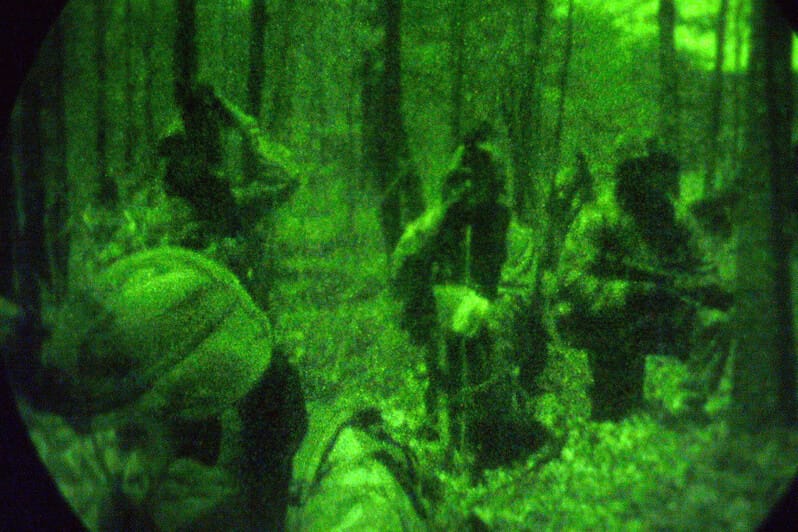
Budget
When buying any type of gear, you don’t want to pay too much and you don’t want to buy gear that breaks easily or has a short product lifespan. Set a budget based on your preference.
As third-generation devices are the latest, they’re also the most expensive.
First-generation devices are getting very cheap and you should be able to buy a good one for less than $200 these days.
Second-generation devices are still pretty expensive, a good one can easily cost $1500 or more.
Third-generation devices are the most expensive ones available as they’re also the latest. A reliable, durable device from a brand like AGM Global Vision, can easily cost over $3000.
Build Quality Weight & Size
The casing of the night vision goggles is very important. You should choose a sturdy metal casing to protect your monocular from knocks and drops. If you choose a model with a plastic casing, the night vision goggles can break down quickly. A metal housing does mean that the product weighs more.
Monoculars have one eyepiece, which means you can see with one eye only, just like telescopes. But night vision monoculars are much more compact than telescopes. Their compactness is what makes them a better option than binoculars.
When transporting hunting equipment, you should choose as much lightweight equipment as possible. A nigh vision monocular can easily fit into pockets or small bags, but some can be quite heavy.
Viewing Distance & Image Quality
The viewing distance and image quality of night vision monoculars depend mainly on the generation. The third generation viewers have the largest viewing distance and the best image quality and the first-generation has the smallest and the worst image quality. The object you’re trying to see also plays a role, a larger object like a building is easier to see than a small object like a rabbit. The amount of residual light also has an influence, the more residual light present the better you will see.
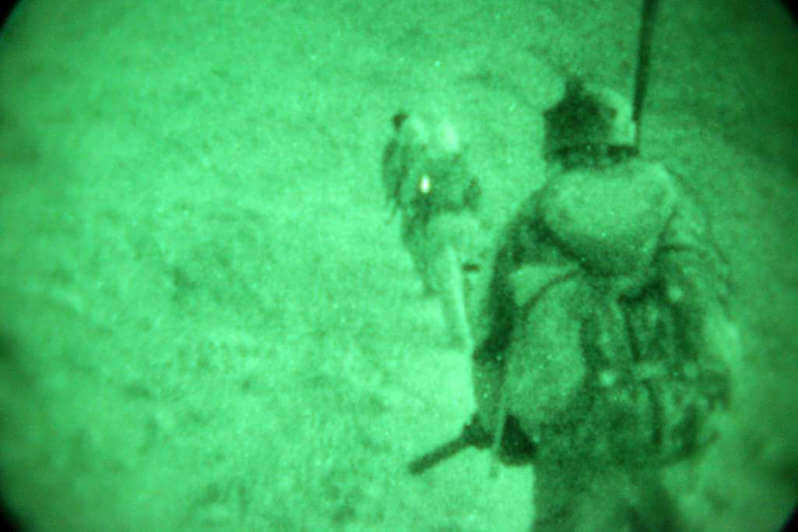
Magnification
A night vision monocular enhances an image the same way a scope does. The difference is that a night vision monocular makes use of infrared light to form an image. The lens in a night vision monocular is not an ordinary one; it has a photo-cathode unit. When infrared hits the unit, it activates the electrons and causes a chain reaction.
The activated electron hits the phosphor-coated screen and forms a green image when observed through a night vision monocular.
Battery Life
Battery life is a pretty important factor when choosing a night vision monocular. A very cheap night vision monocular might only have a battery life of a couple of hours, while a more expensive one is able to easily run for 10 hours or more.
While the battery life is important, the type of battery and how it’s placed is also important. Some night vision monoculars have built-in batteries which aren’t serviceable. This means that you can throw your device in the trash once the battery is dead.
It’s best to find a night vision monocular with an exchangeable lithium battery. These batteries have a longer life span and once the batteries are dead you can easily replace them.
Mounting Options
Some night vision monoculars can be mounted on rifles, helmets, and tripods.
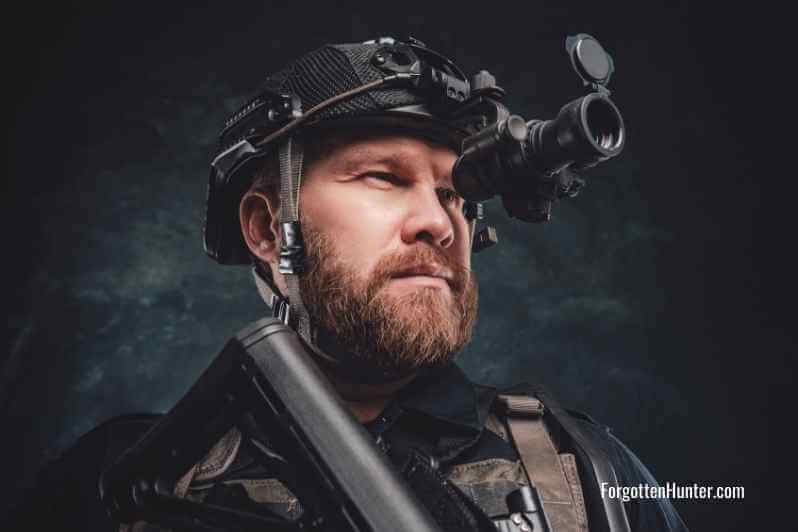
If you’re looking to specifically get a night vision device for your rifle, you should consider getting a night vision scope. A night vision scope is more suited for just hunting at night and will include more features like a built-in rangefinder.
Extra Features
The latest digital night vision monoculars not only allow you to view through them, but also have a built-in camera. This allows you to take pictures or record videos at night. This might be a handy option if you’d like to document your scout or hunt. There are even monoculars that have the possibility of streaming these images live!
Waterproof and weather resistant are another couple of important factors. While (most) generation 3 devices will be waterproof, weather-resistant, and durable, generation 1 and digital devices will almost certainly break down when they get wet.
Previously, monoculars were detested because they required one hand to constantly hold the device while you could shoot with the other. The night vision monoculars at https://www.agmglobalvision.com/ can be attached to a rifle.
The hands-free function of monoculars has helped hunters to a great extent. You can now easily attach the monocular as a scope on the back of your rifle. Some models have special brackets where you can mount your weapon, and, as there is no reticle, you can attach a laser target pointer to make hunting easier.
Night Vision Monocular FAQ
Can I attach a night vision monocular to a rifle?
Yes. With an extra plate, you can attach most monoculars to a rifle.
Can a night vision monocular be used in daylight?
This depends on the type and model.

